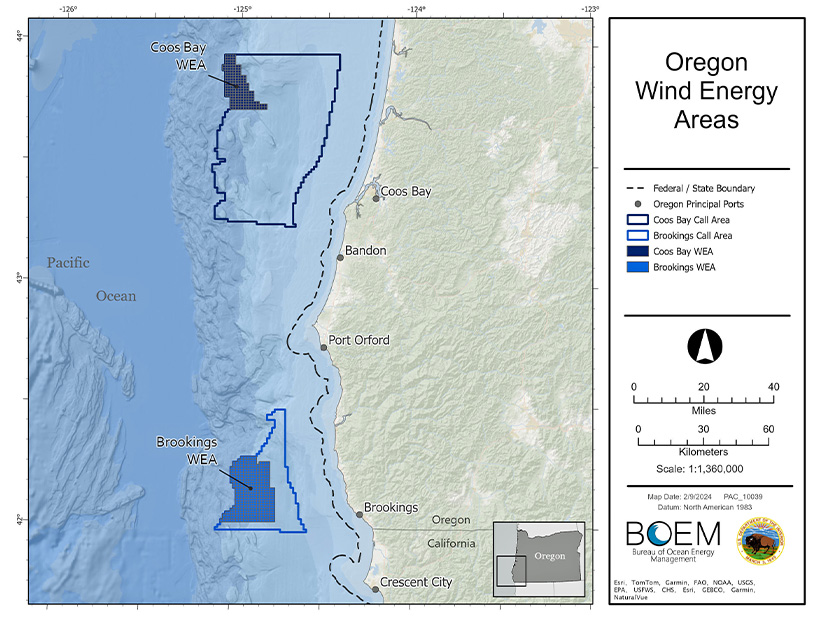
Federal regulators have finalized two Oregon wind energy areas they hope someday will host floating wind turbines with a combined capacity of up to 2.4 GW.
The potential development has drawn the same criticisms leveled by opponents of East Coast proposals: It is ugly, expensive and potentially harmful to the ocean ecosystem and those who rely on it for their livelihood.
But the U.S. Bureau of Ocean Energy Management said the Oregon WEAs incorporate adjustments made to reflect extensive feedback from the state, local residents, tribes and other stakeholders.
BOEM said the WEA boundaries are drawn to avoid conflict with other ocean users, particularly commercial fishers. They exclude 98% of areas recommended for exclusion because of their importance as commercial fishing grounds.
BOEM next will prepare an assessment of the potential environmental impact of placement of turbines and their electrical infrastructure within the WEAs.
The Coos Bay WEA totals 61,204 acres and stands 32 miles offshore; the Brookings WEA is 133,308 acres and is about 18 miles from the coast.
BOEM is following the framework it used in developing other WEAs, gradually refining the geography through multistep review and public comment.
It identified two call areas totaling 1.15 million acres for initial consideration in April 2022, then narrowed them down to two draft WEAs totaling 219,568 acres in August 2023. The final WEAs total 195,012 acres.
BOEM received roughly 1,150 comments on the draft WEAs, many of them form letters but 691 with unique content. They run the gamut from opposition to support, with impact on fishing raised as a frequent concern by opponents.
The local opposition has been strong enough that Gov. Tina Kotek (D) and four members of Oregon’s congressional delegation in June 23 asked BOEM to pause its runup to the leasing process so that state officials could better identify, understand and respond to local concerns.
In November, the Tribal Council of the Confederated Tribes of the Coos, Lower Umpqua and Siuslaw Indians unanimously declared opposition to wind energy development off the Oregon coast.
BOEM notes that the wind off the Oregon coast is strong and consistent, offering a theoretical capacity of up to 62 GW.
But the sea floor slopes off sharply on that portion of the outer continental shelf, limiting the siting options. BOEM considers 1,300 meters to be the limit for economically competitive offshore wind installations with existing technology.
The water depth in the two WEAs ranges from 567 to 1,531 meters, too deep for the fixed-bottom foundations being used in the early stages of East Coast offshore wind energy development. But the technology and design of floating alternatives still are being developed.
BOEM flags another hurdle facing development of the two WEAs: The Oregon Department of Energy indicated significant investment likely would be needed in the onshore grid to handle the output of any large-scale offshore projects — no single interconnection point on the Oregon’s coast grid can accommodate 2 GW. But such an investment would benefit development of onshore renewable energy, as well.
After BOEM’s announcement Tuesday, Kotek responded with a prepared statement that was neutrally worded.
But she said offshore wind likely is to be an important component of meeting the state’s 2040 goal of 100% renewable energy, and potentially also an economic boost for coastal communities.
“As BOEM moves forward with establishing a federal offshore wind leasing process this year, Oregon is committed to developing a robust and transparent state roadmap to inform offshore wind opportunities,” Kotek said. “This state roadmap will also ensure that coastal communities and Tribal nations are consulted throughout the process


